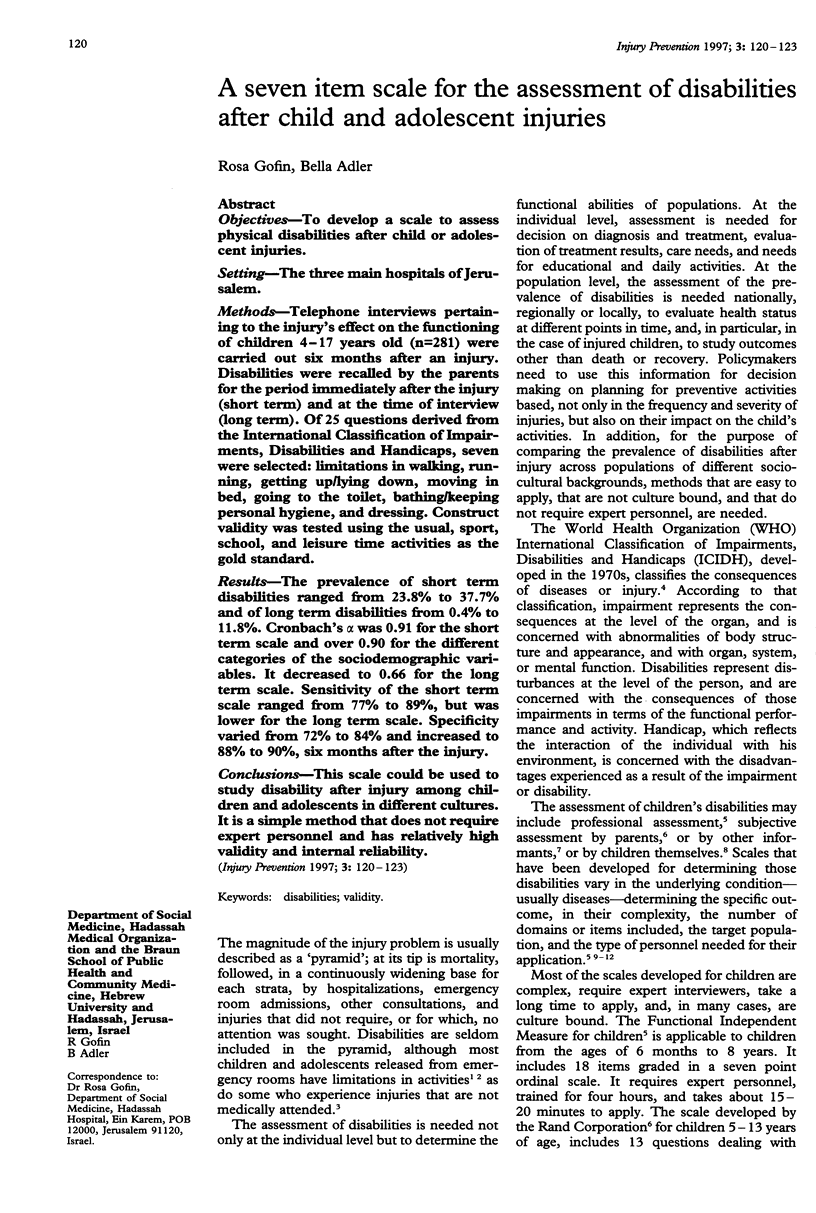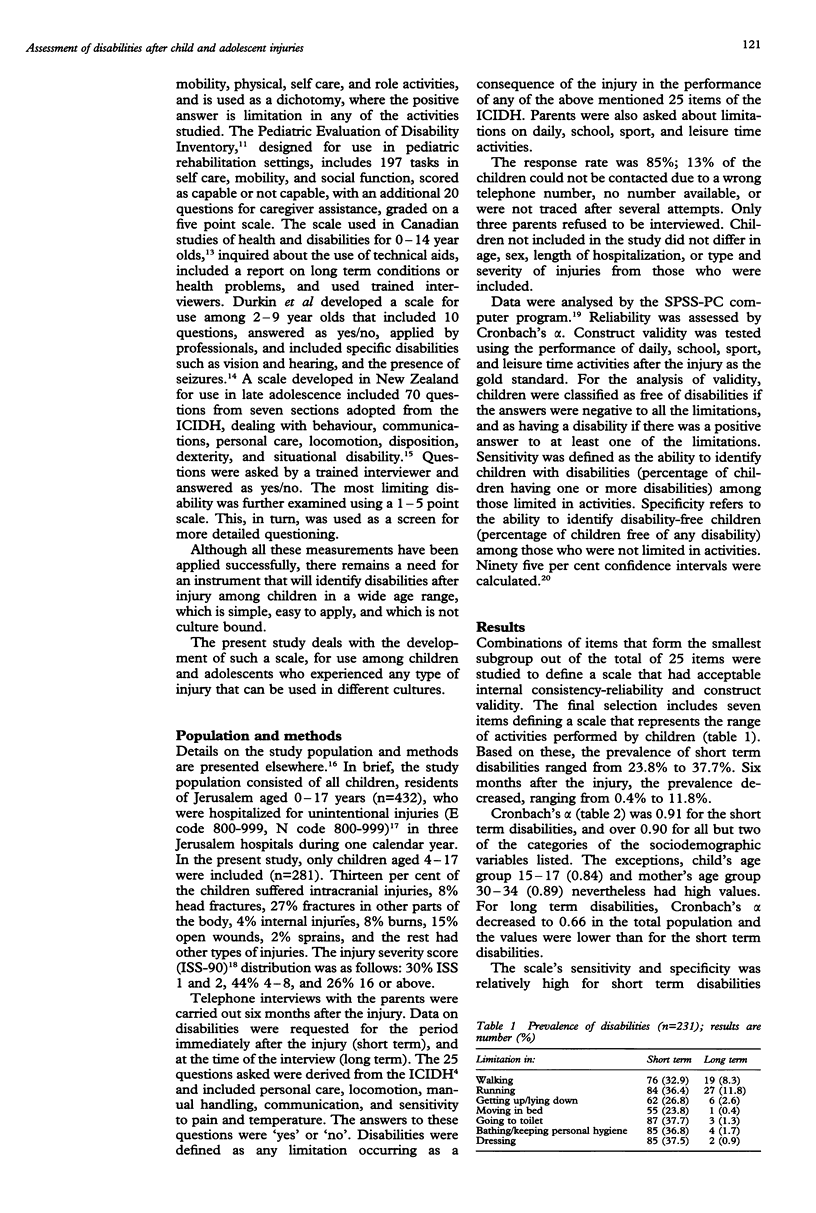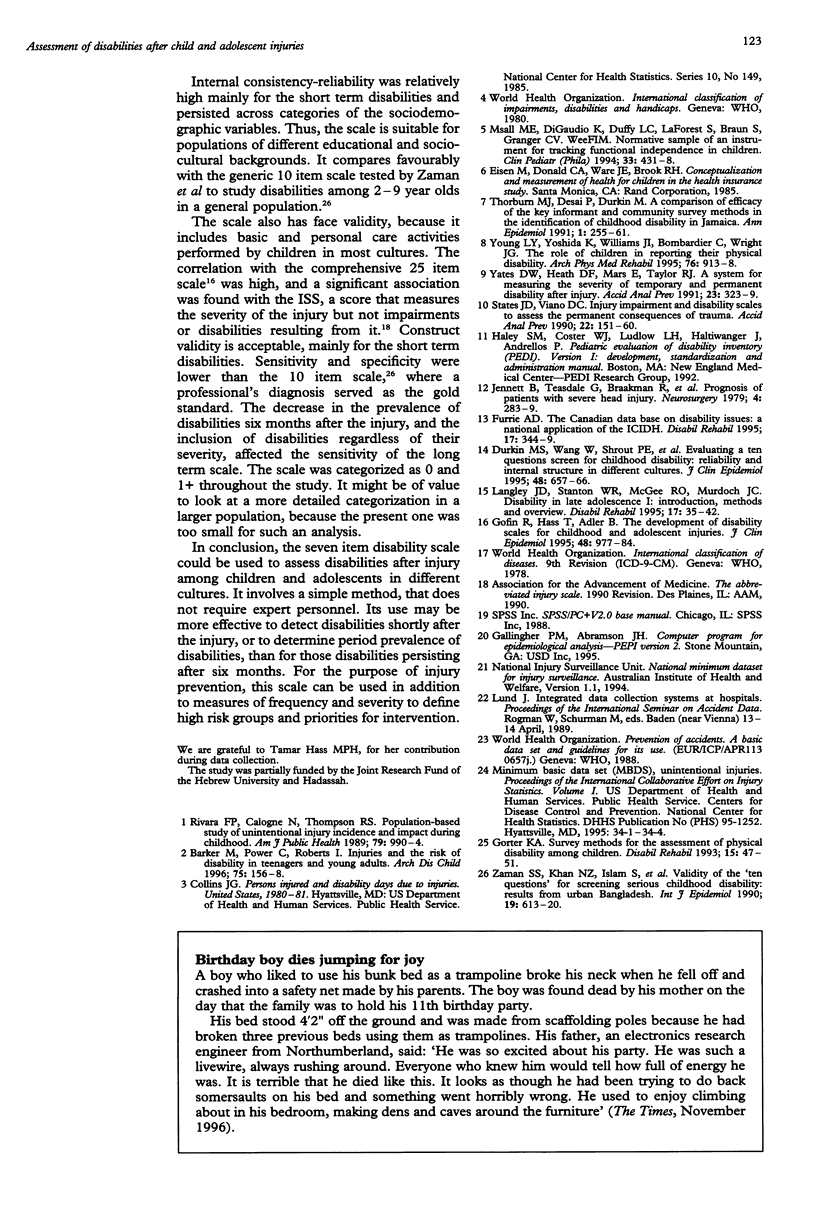Abstract
OBJECTIVES: To develop a scale to assess physical disabilities after child or adolescent injuries. SETTING: The three main hospitals of Jerusalem. METHODS: Telephone interviews pertaining to the injury's effect on the functioning of children 4-17 years old (n = 281) were carried out six months after an injury. Disabilities were recalled by the parents for the period immediately after the injury (short term) and at the time of interview (long term). Of 25 questions derived from the International Classification of Impairments, Disabilities and Handicaps, seven were selected: limitations in walking, running, getting up/lying down, moving in bed, going to the toilet, bathing/keeping personal hygiene, and dressing. Construct validity was tested using the usual, sport, school, and leisure time activities as the gold standard. RESULTS: The prevalence of short term disabilities ranged from 23.8% to 37.7% and of long term disabilities from 0.4% to 11.8%. Cronbach's alpha was 0.91 for the short term scale and over 0.90 for the different categories of the sociodemographic variables. It decreased to 0.66 for the long term scale. Sensitivity of the short term scale ranged from 77% to 89%, but was lower for the long term scale. Specificity varied from 72% to 84% and increased to 88% to 90%, six months after the injury. CONCLUSIONS: This scale could be used to study disability after injury among children and adolescents in different cultures. It is a simple method that does not require expert personnel and has relatively high validity and internal reliability.
Full text
PDF



Selected References
These references are in PubMed. This may not be the complete list of references from this article.
- Barker M., Power C., Roberts I. Injuries and the risk of disability in teenagers and young adults. Arch Dis Child. 1996 Aug;75(2):156–158. doi: 10.1136/adc.75.2.156. [DOI] [PMC free article] [PubMed] [Google Scholar]
- Durkin M. S., Wang W., Shrout P. E., Zaman S. S., Hasan Z. M., Desai P., Davidson L. L. Evaluating a ten questions screen for childhood disability: reliability and internal structure in different cultures. J Clin Epidemiol. 1995 May;48(5):657–666. doi: 10.1016/0895-4356(94)00163-k. [DOI] [PubMed] [Google Scholar]
- Furrie A. D. The Canadian database on disability issues: a national application of the ICIDH. Disabil Rehabil. 1995 Oct;17(7):344–349. doi: 10.3109/09638289509166720. [DOI] [PubMed] [Google Scholar]
- Gofin R., Hass T., Adler B. The development of disability scales for childhood and adolescent injuries. J Clin Epidemiol. 1995 Jul;48(7):977–984. doi: 10.1016/0895-4356(94)00198-y. [DOI] [PubMed] [Google Scholar]
- Gorter K. A. Survey methods for the assessment of physical disability among children. Disabil Rehabil. 1993 Jan-Mar;15(1):47–51. doi: 10.3109/09638289309165871. [DOI] [PubMed] [Google Scholar]
- Jennett B., Teasdale G., Braakman R., Minderhoud J., Heiden J., Kurze T. Prognosis of patients with severe head injury. Neurosurgery. 1979 Apr;4(4):283–289. doi: 10.1227/00006123-197904000-00001. [DOI] [PubMed] [Google Scholar]
- Langley J. D., Stanton W. R., McGee R. O., Murdoch J. C. Disability in late adolescence. I: Introduction, methods, and overview. Disabil Rehabil. 1995 Jan;17(1):35–42. doi: 10.3109/09638289509166625. [DOI] [PubMed] [Google Scholar]
- Msall M. E., DiGaudio K., Duffy L. C., LaForest S., Braun S., Granger C. V. WeeFIM. Normative sample of an instrument for tracking functional independence in children. Clin Pediatr (Phila) 1994 Jul;33(7):431–438. doi: 10.1177/000992289403300709. [DOI] [PubMed] [Google Scholar]
- Rivara F. P., Calonge N., Thompson R. S. Population-based study of unintentional injury incidence and impact during childhood. Am J Public Health. 1989 Aug;79(8):990–994. doi: 10.2105/ajph.79.8.990. [DOI] [PMC free article] [PubMed] [Google Scholar]
- States J. D., Viano D. C. Injury impairment and disability scales to assess the permanent consequences of trauma. Accid Anal Prev. 1990 Apr;22(2):151–160. doi: 10.1016/0001-4575(90)90066-t. [DOI] [PubMed] [Google Scholar]
- Thorburn M. J., Desai P., Durkin M. A comparison of efficacy of the key informant and community survey methods in the identification of childhood disability in Jamaica. Ann Epidemiol. 1991 Feb;1(3):255–261. doi: 10.1016/1047-2797(91)90004-v. [DOI] [PubMed] [Google Scholar]
- Yates D. W., Heath D. F., Mars E., Taylor R. J. A system for measuring the severity of temporary and permanent disability after injury. Accid Anal Prev. 1991 Aug;23(4):323–329. doi: 10.1016/0001-4575(91)90010-3. [DOI] [PubMed] [Google Scholar]
- Young N. L., Yoshida K. K., Williams J. I., Bombardier C., Wright J. G. The role of children in reporting their physical disability. Arch Phys Med Rehabil. 1995 Oct;76(10):913–918. doi: 10.1016/s0003-9993(95)80066-2. [DOI] [PubMed] [Google Scholar]
- Zaman S. S., Khan N. Z., Islam S., Banu S., Dixit S., Shrout P., Durkin M. Validity of the 'Ten Questions' for screening serious childhood disability: results from urban Bangladesh. Int J Epidemiol. 1990 Sep;19(3):613–620. doi: 10.1093/ije/19.3.613. [DOI] [PubMed] [Google Scholar]


